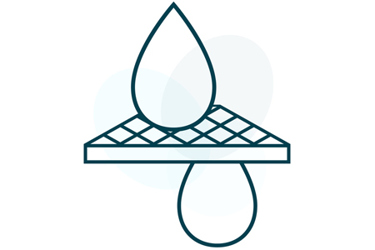Breakthrough Recyclable Polyimide Membranes Transform Wastewater And High-Salinity Water Treatment
By Toheeb Obidara

Global water scarcity intensifies, caused by climate instability and insufficient access to freshwater, especially in water-stressed countries. Desalination has emerged as a significant source of freshwater due to the abundance of seawater. Although conventional desalination methods, such as reverse osmosis, treat seawater effectively, they encounter limitations when applied to hypersaline industrial brines, concentrated chemical effluents, and produced water from oil and gas. These streams frequently cause fouling or damage to existing membranes, leaving industries with very few viable, cost-effective treatment options. Membrane distillation (MD), which allows only vapor to pass through membranes, offers a promising alternative for these challenging separations.
Researchers at the Membrane for Water and Energy Lab at King Fahd University of Petroleum & Minerals (KFUPM) in Saudi Arabia have developed polyimide-based membranes for membrane distillation (MD) that overcome three persistent issues in membranes for water treatment and gas separations: the need for pore-forming chemicals that prevent recycling, performance degradation due to pore wetting and fouling, and the inherent trade-off between high water flux and selectivity. These membranes achieve higher water flux rates than commercial membranes while maintaining over 99.9% salt rejection for solutions containing 70,000 ppm dissolved salts, nearly double the salinity of seawater. Most significantly, they are recyclable, preventing waste accumulation in landfills.
The team’s initial study on this membrane material, published in Desalination (2023), introduced intrinsically porous polyimide membranes for high-salinity feed. The polymer, 4,4′-(hexafluoroisopropylidene) diphtalic anhydride (6FDA) and 2,3,5,6-tetramethyl-p-phenylenediamine (TMPD), i.e., 6FDA-TMPD, was prepared from polycondensation reaction. Additionally, the polymer showed properties such as thermal stability above 500º C and surface area of 550 m2/g, indicating a substantial porous network. The membranes were fabricated through phase inversion without chemical additives, modifying the structure from finger-like to sponge-like morphology with interconnected pores. The performance of membranes was tested in a membrane distillation setup using synthetic saline water (70,000 ppm NaCl) and real seawater from the Arabian Gulf, which yielded excellent results with 99.9% salt rejection without nanoparticles or surface treatments. This demonstrated that intrinsic polymer structure could eliminate the need for additives, reducing chemical use and producing membranes resistant to wetting and fouling.
The subsequent study on this polymer, also published in Desalination (2025), explored a surface engineering approach using vapor-assisted phase separation as an alternative to conventional liquid-based fabrication. Instead of immersing cast polymer films in liquid baths, this technique exposes the membranes directly to vapors, allowing control over pore size, connectivity, and surface texture. The slow vapor penetration allows polymer chains to rearrange more uniformly, resulting in optimal structure formation. The membranes developed highly interconnected pore networks with hydrophobicity reaching a contact angle of 141.6º, one of the highest ever reported for polyimide membranes, achieved through structure control without any chemical modification.
The third study, published in the Journal of Environmental Chemical Engineering in 2025, extends beyond materials synthesis into machine learning and membrane distillation optimization for possible scale-up of the system. The team employed machine learning models, specifically boosted trees and adaptive neuro-fuzzy inference system (ANFIS), to predict and optimize membrane performance through parametric conditions. Through 132 experiments varying feed temperature, salinity, and flow rates, the researchers validated their models using real Arabian Gulf seawater (48, 2000 ppm).
These studies demonstrate systematic progression from material innovation to sustainable fabrication and intelligent optimization. First, we establish polyimides as a substantial material for MD membranes in desalination, delivering high flux and stable rejection without relying on additives. Second, we introduce recyclable, surface-engineered structures fabricated through cleaner and scalable methods. And finally, they show how AI can optimize operations, bridging the gap between laboratory prototypes and intelligent, field-ready systems. The membranes’ exceptional performance makes them suitable for diverse industrial applications, including chemical manufacturing, pharmaceutical production, and textile operations, which generate wastewater with elevated dissolved salts and organic contaminants. For instance, in lithium extraction, where solar evaporation ponds require 12 to18 months, membrane distillation could significantly accelerate this process while recovering reusable water, offering both environmental and economic advantages.
“Our next phase will focus on scaling up production and testing membranes under real industrial conditions,” according to Toheeb Obidara, one of the research team members. The team plans to integrate MD systems with renewable heat sources and digital monitoring platforms to ensure they are not only effective but also adaptive and sustainable. These innovations in polyimide membrane distillation represent more than laboratory success. They are a tangible path toward sustainable water security and set the stage for the next generation of desalination systems capable of meeting one of the world’s most urgent needs.
 Toheeb Obidara is a PhD student in the Department of Chemical Engineering at Northeastern University in Boston. He had his master's degree in Materials Science and Engineering from King Fahd University of Petroleum & Minerals (KFUPM), where he developed polyimide membranes for water treatment. His research interest lies in developing innovative materials. Currently, he is investigating flow dynamics of hydrogel derived from the crosslinked biopolymers, given their relevance in bioseparations and drug delivery applications.
Toheeb Obidara is a PhD student in the Department of Chemical Engineering at Northeastern University in Boston. He had his master's degree in Materials Science and Engineering from King Fahd University of Petroleum & Minerals (KFUPM), where he developed polyimide membranes for water treatment. His research interest lies in developing innovative materials. Currently, he is investigating flow dynamics of hydrogel derived from the crosslinked biopolymers, given their relevance in bioseparations and drug delivery applications.
